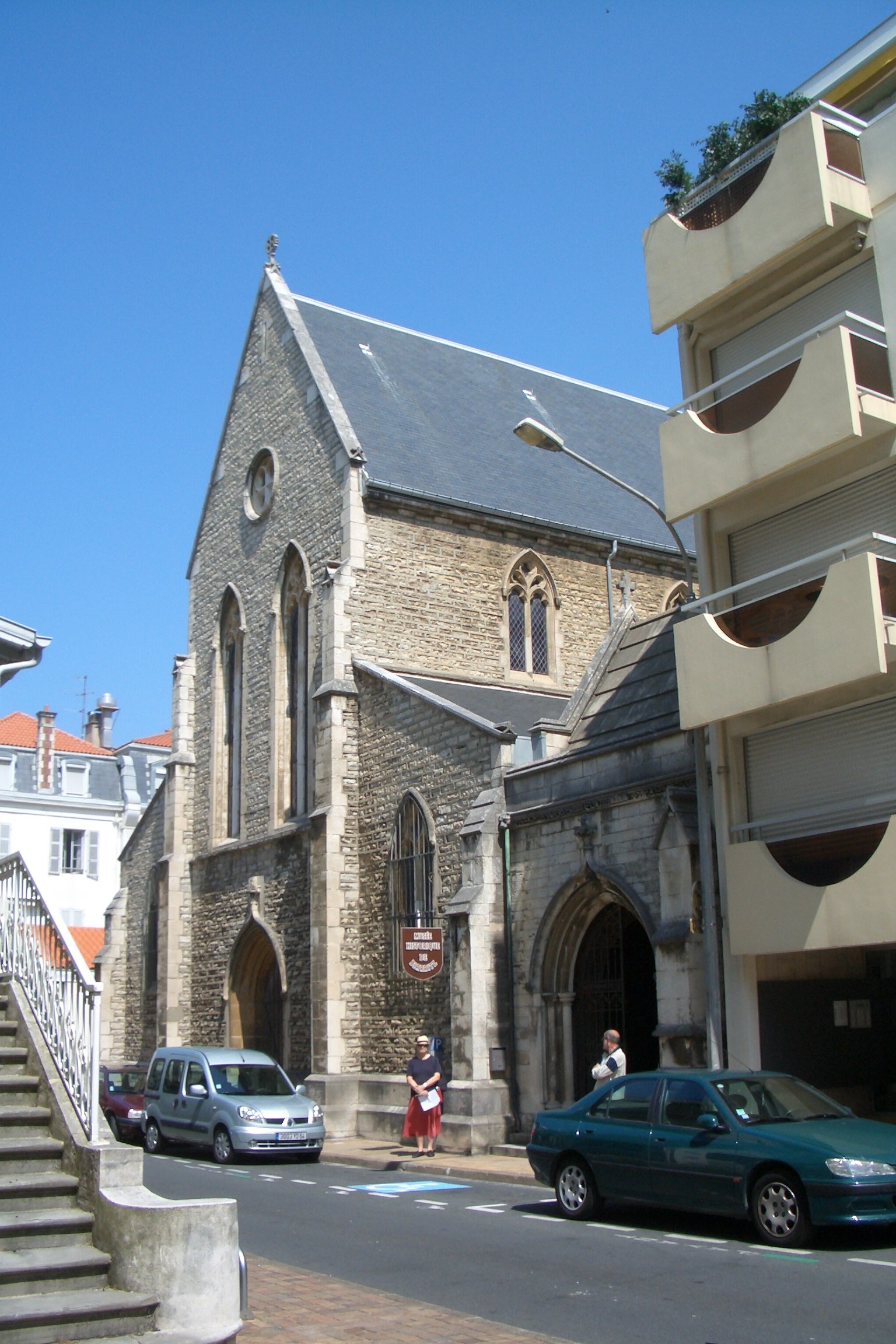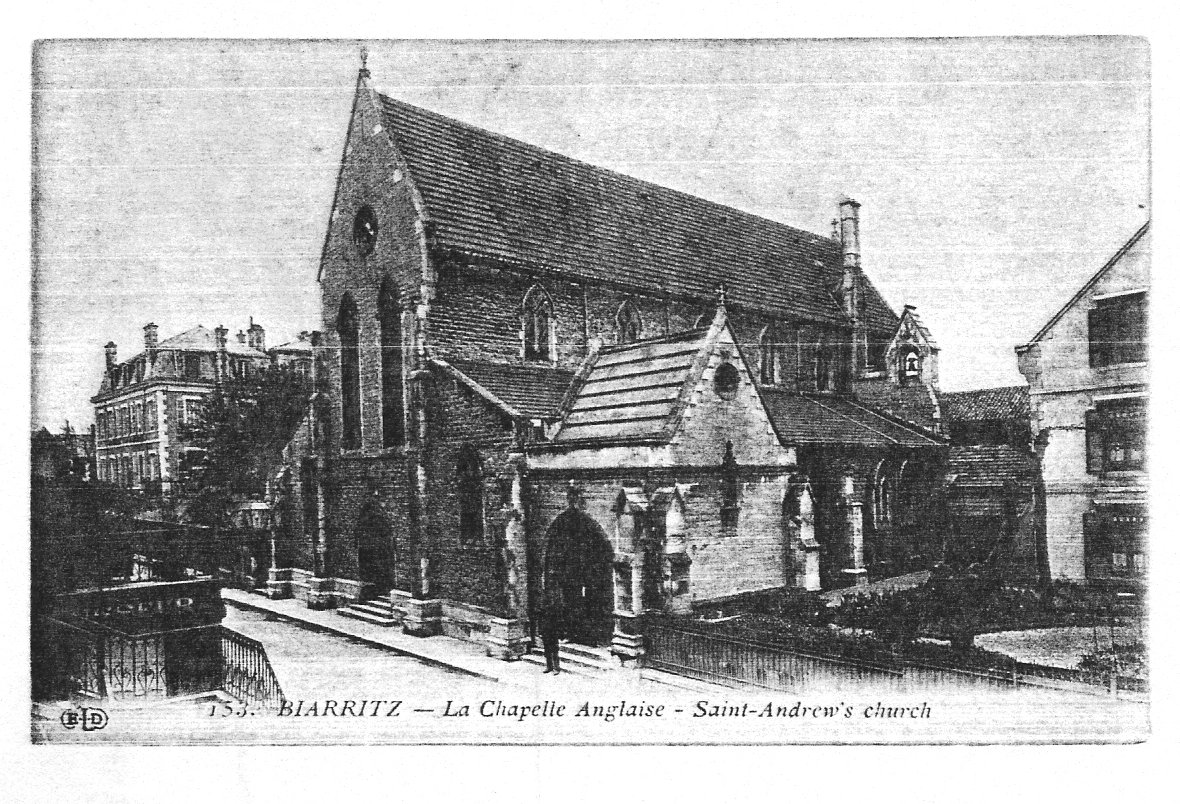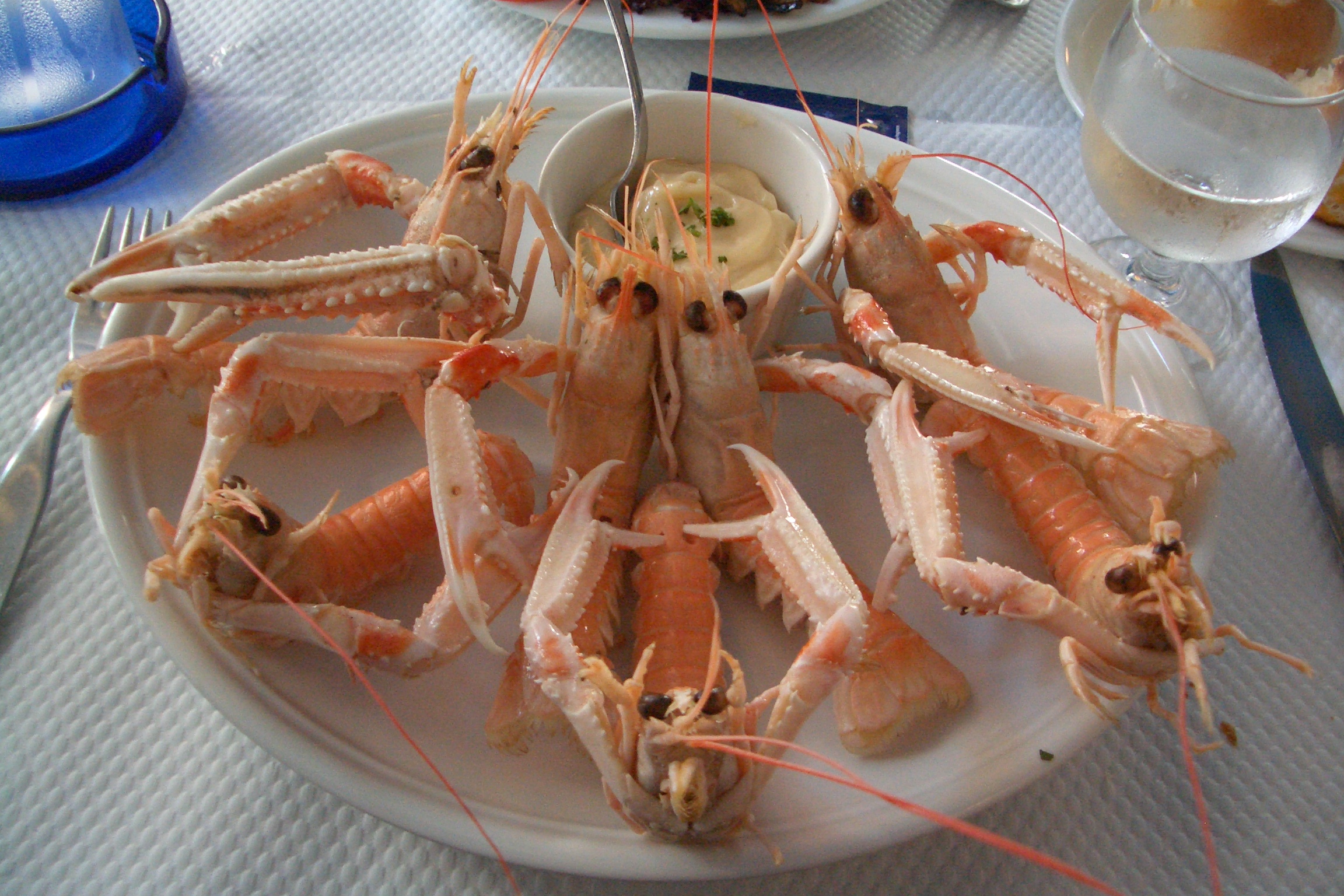24 June 2006, The Church

 Yesterday, David slept in, so we got a late start on the morning (but I got caught up on the blog). Once he'd had his breakfast (snatching the last croissant from the basket as the waitresses cleared the buffet), we set off to find St. Andrew's, the decommissioned Anglican church that now houses the Museum of the History of Biarritz. The route passed right through the city's main restaurant district, so we read menus all the way, prospecting for lunch. We got to the church about 11:30 a.m., just half an hour before it was scheduled to close for the usual two-hour French lunch period. So we hung around long enough to take photos approximating the view in the 1918-vintage postcard that Grandpa sent home to his mom when he and my grandmother were married there, 88 years ago next August 13. We also chatted with the docent, who was standing around with nothing to do, and he was able, first, to confirm for us that the old town hall, where the civil ceremony took place just before they went to St. Andrew's for the religious one, was demolished decades ago to make way for the new one, which was built on the same site, directly across the street from our hotel, and second to tell us that the Hotel Regina, where Grandpa lived during his convalescence (his reason for being in Biarritz), is still going strong. We walked over there this morning and had a look around. It was only about 9 years old in 1918.
Yesterday, David slept in, so we got a late start on the morning (but I got caught up on the blog). Once he'd had his breakfast (snatching the last croissant from the basket as the waitresses cleared the buffet), we set off to find St. Andrew's, the decommissioned Anglican church that now houses the Museum of the History of Biarritz. The route passed right through the city's main restaurant district, so we read menus all the way, prospecting for lunch. We got to the church about 11:30 a.m., just half an hour before it was scheduled to close for the usual two-hour French lunch period. So we hung around long enough to take photos approximating the view in the 1918-vintage postcard that Grandpa sent home to his mom when he and my grandmother were married there, 88 years ago next August 13. We also chatted with the docent, who was standing around with nothing to do, and he was able, first, to confirm for us that the old town hall, where the civil ceremony took place just before they went to St. Andrew's for the religious one, was demolished decades ago to make way for the new one, which was built on the same site, directly across the street from our hotel, and second to tell us that the Hotel Regina, where Grandpa lived during his convalescence (his reason for being in Biarritz), is still going strong. We walked over there this morning and had a look around. It was only about 9 years old in 1918.
 Rather than start seeing the museum so close to the noon closure, we went off to find lunch, promising to return at 2 p.m. After walking the length of Rue du Port Vieux (no, I don't know why "vieux," which usually comes before the noun, always follows it here), we settled on "La Goelette." David had a "salade forestière," a heap of greens with the usual wonderful French vinaigrette smothered in a heap of bacon pieces, sautéed onions, and hot sautéed mushrooms strongly flavored with sherry and topped by a soft, warm poached egg. I had "langoustines mayonnaise," seven very large cold, cooked langoustines (Nephrops norvegicus), each folded into the "about-to-take-flight" position popular here, served with a ramekin of house-made mayo. Delicious!
Rather than start seeing the museum so close to the noon closure, we went off to find lunch, promising to return at 2 p.m. After walking the length of Rue du Port Vieux (no, I don't know why "vieux," which usually comes before the noun, always follows it here), we settled on "La Goelette." David had a "salade forestière," a heap of greens with the usual wonderful French vinaigrette smothered in a heap of bacon pieces, sautéed onions, and hot sautéed mushrooms strongly flavored with sherry and topped by a soft, warm poached egg. I had "langoustines mayonnaise," seven very large cold, cooked langoustines (Nephrops norvegicus), each folded into the "about-to-take-flight" position popular here, served with a ramekin of house-made mayo. Delicious!
After lunch, we went back and spent a couple of hours thoroughly exploring the church/museum. Its dominant themes were
(a) Whaling: Back before whales got rare, Biarritz was a major whaling center—not a base for large ships that went out for three years at a time, as in Moby Dick, but in an actual coastal fishery. A lookout sat on a hill watching for whales, and when a pod was sighted, he'd ring a big bell. The locals would leave their work in the fields, dash to their waiting 8- to 10-man boats, and row like crazy. They would chase down a whale, harpoon it, and wrestle it into submission just like the New England whalers, but then would tow it ashore, beach it at Port Vieux, and process it there. Blubber would be rendered for lamp oil; the balleen used for corset stays, colar stays, umbrella ribs, fans, and other decorative items; the teeth carved as ivory; the bones used for construction (!); and the meat sold in the local markets.
(b) Visiting dignitaries: Biarritz has a long history as a tourist destination and summer resort, which reached its apex in its discovery by Napoleon III and his empress, Eugenie, who built an actual imperial residence here, now the Hotel du Palais, where we have dinner reservations for two nights. So many members of the Russian aristocracy hung out here that there's still a lovely Russian orthodox church almost across from palace.
(c) Local dignitaries: They have portraits of all the mayors, including M. Forsan, mayor from 1909 to 1919, who performed my grandparents' civil marriage. Apparently a marriage by the mayor himself was considered quite an honor, but this particular marriage had actually become something of a local cause celebre. George and Nancy sucessfully badgered the local British and American consuls (she was Scottish, he American) into the huge amount of bureaucratic paperwork necessary for two foreigners of different nationality to marry legally in France, got the banns posted for 10 days on the courthouse wall, and got written up (after the fact) in the local papers, all while managing to keep the whole thing secret from the 200 other American officers convalescing at the Regina, for fear of a mobbed wedding and honeymoon shivaree.
(d) Local shipwrecks. The freshest in local memory was an old fishing factory ship, being towed home to South America to be scrapped, that broke free of its tug during a violent storm in November of 1995 (four caretaker sailors aboard), threaded its way (without power or steerage way) through the line of rocks just off the coast, and beached itself right in front of the Casino, without casualities. A particularly high tide was expected in mid December, so major engineering forces were mobilized, excavations were undertaken, three especially large tugs were brought in from Brittany, and at 2 a.m. on the appointed day, everybody pushed, pulled, and prayed, and it floated off. They towed it to the nearest submarine canyon (off the coast between Biarritz and Bordeaux), where (apparently taking water from every direction) it was allowed to sink (or "oceanized" as the museum's account put it).
Aside from these four themes, the museum also houses, for no reason I could see other than it's extremely high ceiling, a Foucault pendulum, not in motion while we were there.
previous entry List of Entries next entry
 Rather than start seeing the museum so close to the noon closure, we went off to find lunch, promising to return at 2 p.m. After walking the length of Rue du Port Vieux (no, I don't know why "vieux," which usually comes before the noun, always follows it here), we settled on "La Goelette." David had a "salade forestière," a heap of greens with the usual wonderful French vinaigrette smothered in a heap of bacon pieces, sautéed onions, and hot sautéed mushrooms strongly flavored with sherry and topped by a soft, warm poached egg. I had "langoustines mayonnaise," seven very large cold, cooked langoustines (Nephrops norvegicus), each folded into the "about-to-take-flight" position popular here, served with a ramekin of house-made mayo. Delicious!
Rather than start seeing the museum so close to the noon closure, we went off to find lunch, promising to return at 2 p.m. After walking the length of Rue du Port Vieux (no, I don't know why "vieux," which usually comes before the noun, always follows it here), we settled on "La Goelette." David had a "salade forestière," a heap of greens with the usual wonderful French vinaigrette smothered in a heap of bacon pieces, sautéed onions, and hot sautéed mushrooms strongly flavored with sherry and topped by a soft, warm poached egg. I had "langoustines mayonnaise," seven very large cold, cooked langoustines (Nephrops norvegicus), each folded into the "about-to-take-flight" position popular here, served with a ramekin of house-made mayo. Delicious!
 Yesterday, David slept in, so we got a late start on the morning (but I got caught up on the blog). Once he'd had his breakfast (snatching the last croissant from the basket as the waitresses cleared the buffet), we set off to find St. Andrew's, the decommissioned Anglican church that now houses the Museum of the History of Biarritz. The route passed right through the city's main restaurant district, so we read menus all the way, prospecting for lunch. We got to the church about 11:30 a.m., just half an hour before it was scheduled to close for the usual two-hour French lunch period. So we hung around long enough to take photos approximating the view in the 1918-vintage postcard that Grandpa sent home to his mom when he and my grandmother were married there, 88 years ago next August 13. We also chatted with the docent, who was standing around with nothing to do, and he was able, first, to confirm for us that the old town hall, where the civil ceremony took place just before they went to St. Andrew's for the religious one, was demolished decades ago to make way for the new one, which was built on the same site, directly across the street from our hotel, and second to tell us that the Hotel Regina, where Grandpa lived during his convalescence (his reason for being in Biarritz), is still going strong. We walked over there this morning and had a look around. It was only about 9 years old in 1918.
Yesterday, David slept in, so we got a late start on the morning (but I got caught up on the blog). Once he'd had his breakfast (snatching the last croissant from the basket as the waitresses cleared the buffet), we set off to find St. Andrew's, the decommissioned Anglican church that now houses the Museum of the History of Biarritz. The route passed right through the city's main restaurant district, so we read menus all the way, prospecting for lunch. We got to the church about 11:30 a.m., just half an hour before it was scheduled to close for the usual two-hour French lunch period. So we hung around long enough to take photos approximating the view in the 1918-vintage postcard that Grandpa sent home to his mom when he and my grandmother were married there, 88 years ago next August 13. We also chatted with the docent, who was standing around with nothing to do, and he was able, first, to confirm for us that the old town hall, where the civil ceremony took place just before they went to St. Andrew's for the religious one, was demolished decades ago to make way for the new one, which was built on the same site, directly across the street from our hotel, and second to tell us that the Hotel Regina, where Grandpa lived during his convalescence (his reason for being in Biarritz), is still going strong. We walked over there this morning and had a look around. It was only about 9 years old in 1918.